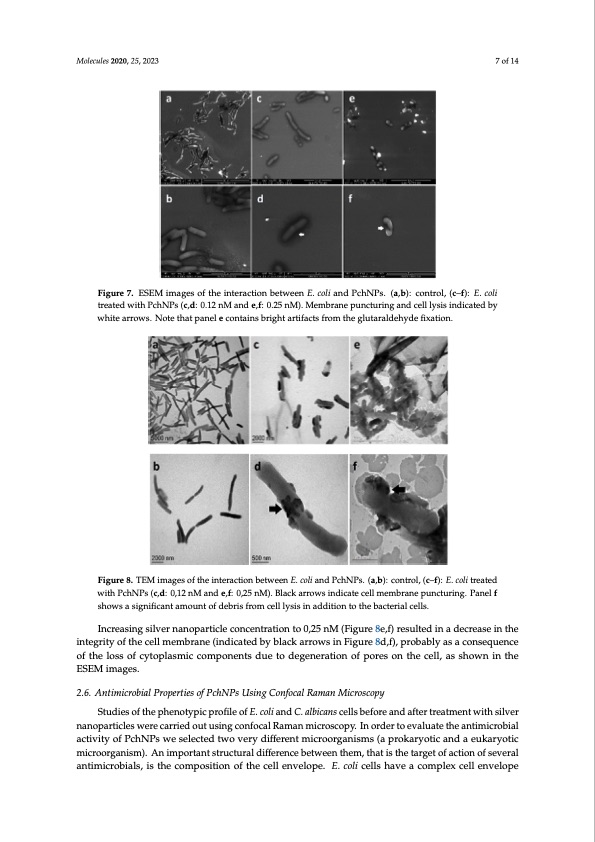
PDF Publication Title:
Text from PDF Page: 007
Molecules 2020, 25, 2023 Molecules 2020, 25, x FOR PEER REVIEW Molecules 2020, 25, x FOR PEER REVIEW Figure 7. ESEM images of the interaction between E. coli and PchNPs. (a,b): control, (c–f): E. coli Figure 7. ESEM images of the interaction between E. coli and PchNPs. (a,b): control, (c–f): E. coli Figure 7. ESEM images of the interaction between E. coli and PchNPs. (a,b): control, (c–f): E. coli treated with PchNPs (c,d: 0.12 nM and e,f: 0.25 nM). Membrane puncturing and cell lysis indicated treated with PchNPs (c,d: 0.12 nM and e,f: 0.25 nM). Membrane puncturing and cell lysis indicated by treated with PchNPs (c,d: 0.12 nM and e,f: 0.25 nM). Membrane puncturing and cell lysis indicated 7 of 14 8 of 15 8 of 15 by white arrows. Note that panel e contains bright artifacts from the glutaraldehyde fixation. white arrows. Note that panel e contains bright artifacts from the glutaraldehyde fixation. by white arrows. Note that panel e contains bright artifacts from the glutaraldehyde fixation. Figure 8. TEM images of the interaction between E. coli and PchNPs. (a,b): control, (c–f): E. coli treated Figure 8. TEM images of the interaction between E. coli and PchNPs. (a,b): control, (c–f): E. coli treated Figure 8. TEM images of the interaction between E. coli and PchNPs. (a,b): control, (c–f): E. coli treated with PchNPs (c,d: 0,12 nM and e,f: 0,25 nM). Black arrows indicate cell membrane puncturing. Panel f with PchNPs (c,d: 0,12 nM and e,f: 0,25 nM). Black arrows indicate cell membrane puncturing. Panel with PchNPs (c,d: 0,12 nM and e,f: 0,25 nM). Black arrows indicate cell membrane puncturing. Panel shows a significant amount of debris from cell lysis in addition to the bacterial cells. f shows a significant amount of debris from cell lysis in addition to the bacterial cells. f shows a significant amount of debris from cell lysis in addition to the bacterial cells. Increasing silver nanoparticle concentration to 0,25 nM (Figure 8e,f) resulted in a decrease in the Increasing silver nanoparticle concentration to 0,25 nM (Figure 8e,f) resulted in a decrease in the Increasing silver nanoparticle concentration to 0,25 nM (Figure 8e,f) resulted in a decrease in the integrity of the cell membrane (indicated by black arrows in Figure 8d,f), probably as a consequence integrity of the cell membrane (indicated by black arrows in Figure 8d,f), probably as a consequence integrity of the cell membrane (indicated by black arrows in Figure 8d,f), probably as a consequence of the loss of cytoplasmic components due to degeneration of pores on the cell, as shown in the of the loss of cytoplasmic components due to degeneration of pores on the cell, as shown in the ESEM of the loss of cytoplasmic components due to degeneration of pores on the cell, as shown in the ESEM ESEM images. images. images. 2.6. Antimicrobial Properties of PchNPs Using Confocal Raman Microscopy 2.6. Antimicrobial Properties of PchNPs Using Confocal Raman Microscopy 2.6. Antimicrobial Properties of PchNPs Using Confocal Raman Microscopy Studies of the phenotypic profile of E. coli and C. albicans cells before and after treatment with silver Studies of the phenotypic profile of E. coli and C. albicans cells before and after treatment with nanopStaurtdicielessowfethrecpahrreinedotoyupticuspinrogficloenofofcEa.lcRoalimaanndmCi.carolbsicoapnsy.cIenllosrbdefrotroeeavnadluaftteetrhtereaanttmimeinctrowbitahl silver nanoparticles were carried out using confocal Raman microscopy. In order to evaluate the asciltviveritynaonfoPpcahrNticPlseswweesreelecaterrdietdwouvteruysidnigffecroenftocmailcRroaomrgaannmismicrso(sacopproyk.aInryortidcearntdoaeveaulkuartyeotthice antimicrobial activity of PchNPs we selected two very different microorganisms (a prokaryotic and manictirmooicrgroabniasmla)c.tAivnitiymopfoPrctahnNtPstsruwcetusrealledctieffdertewncoevbertywdeeifnfetrheenmt,mthicartoiosrtghaentiasrmgest(oafpacrtoikoanroyfosteicvearnadl a eukaryotic microorganism). An important structural difference between them, that is the target of anetuimkaicrryobticalms,icisrotohregcaonmismpo)s.iAtinonimopf othrteancetlsltreuncvteulroapled.ifEfe.rceonliceceblelstwheaevnetahecmom, tphlaetxiscetlhleetnavrgeleotpoef action of several antimicrobials, is the composition of the cell envelope. E. coli cells have a complex action of several antimicrobials, is the composition of the cell envelope. E. coli cells have a complex cell envelope composed of the cytoplasmic membrane, the periplasm with a thin peptidoglycan layer, cell envelope composed of the cytoplasmic membrane, the periplasm with a thin peptidoglycan layer,PDF Image | Biofilm Eradication Using Biogenic Silver Nanoparticles

PDF Search Title:
Biofilm Eradication Using Biogenic Silver NanoparticlesOriginal File Name Searched:
molecules-25-02023-v2.pdfDIY PDF Search: Google It | Yahoo | Bing
Turbine and System Plans CAD CAM: Special for this month, any plans are $10,000 for complete Cad/Cam blueprints. License is for one build. Try before you buy a production license. More Info
Waste Heat Power Technology: Organic Rankine Cycle uses waste heat to make electricity, shaft horsepower and cooling. More Info
All Turbine and System Products: Infinity Turbine ORD systems, turbine generator sets, build plans and more to use your waste heat from 30C to 100C. More Info
CO2 Phase Change Demonstrator: CO2 goes supercritical at 30 C. This is a experimental platform which you can use to demonstrate phase change with low heat. Includes integration area for small CO2 turbine, static generator, and more. This can also be used for a GTL Gas to Liquids experimental platform. More Info
Introducing the Infinity Turbine Products Infinity Turbine develops and builds systems for making power from waste heat. It also is working on innovative strategies for storing, making, and deploying energy. More Info
Need Strategy? Use our Consulting and analyst services Infinity Turbine LLC is pleased to announce its consulting and analyst services. We have worked in the renewable energy industry as a researcher, developing sales and markets, along with may inventions and innovations. More Info
Made in USA with Global Energy Millennial Web Engine These pages were made with the Global Energy Web PDF Engine using Filemaker (Claris) software.
Infinity Turbine Developing Spinning Disc Reactor SDR or Spinning Disc Reactors reduce processing time for liquid production of Silver Nanoparticles.
| CONTACT TEL: 608-238-6001 Email: greg@infinityturbine.com | RSS | AMP |